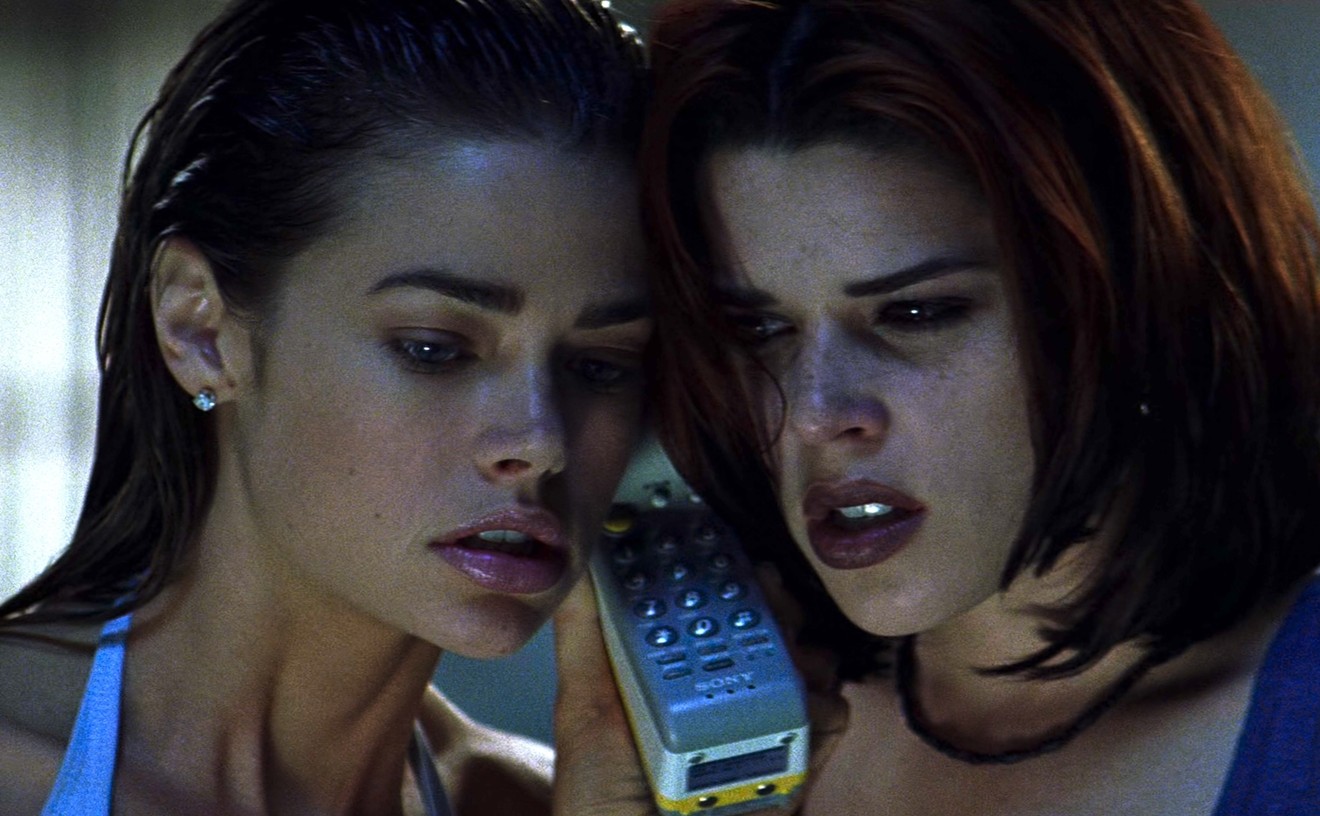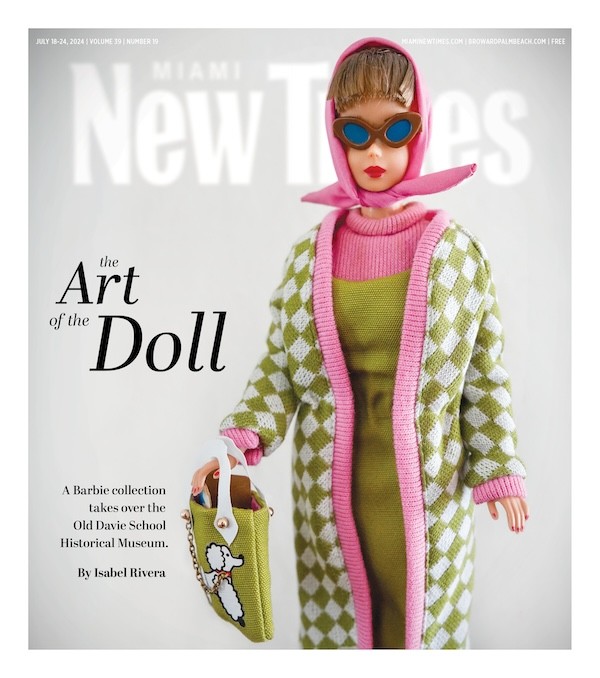Lately Basquiat has been the subject of considerable attention off-screen as well. In October his painting Pyro was sold in London at Sotheby's for $365,000 -- a neat sum for a contemporary artist. But it did not approach the $550,000 one of his works garnered at auction in 1989, the year after his death at age 27 from a heroin overdose, which momentarily jacked up his prices astronomically. (For an idea of how Basquiat's work appreciated when he was alive, consider that a painting that sold at auction for $19,000 in 1982 had been purchased by the seller the year before for $4000.) During the past year, Tony Schafrazi and Robert Miller held shows of Basquiat's work in their New York spaces, as have galleries in Paris and London.
Here in Miami the Museum of Contemporary Art's exhibition of Basquiat's silkscreened "Blue Ribbon Paintings" series happened to coincide with the local run of the Schnabel movie. And MoCA's show was preceded last year by a potent selection of Basquiat drawings displayed at Miami-Dade Community College's Centre Gallery downtown.
Now Quintana Gallery in Coral Gables is showing 28 paintings, drawings, and objects by Basquiat. The works all belong to private collectors; the owners of five of these pieces are willing to part with them for six-figure prices. Gallery owner Fernando Quintana may have increased the likelihood of such an occurrence by scheduling his show when droves of collectors and dealers are certain to roll into town for Art Miami 1997, which starts Wednesday, January 8, at the Miami Beach Convention Center, and for the first-ever Gramercy International Art Fair, at the Raleigh Hotel next weekend. (See "Calendar," page 27.)
Marketing aside, Quintana has done a favor to the local public by putting together the most extensive show of Basquiat's work in Miami to date. There are outstanding paintings here, although some examples of the conspicuously commercial works the artist quickly knocked off to please eager clients on his dealer's waiting list are also present.
The subject matter and style of the early paintings would reappear in Basquiat's work throughout his career. The crown is one image he depicted repeatedly; it is seen here in Red Kings -- two crowned skeletal faces painted in red on a wood-framed window -- and also in a raw portrait on canvas of the boxer Jersey Joe Walcott, one of the black sports heroes to whom Basquiat paid frequent homage.
Aaron -- a reference to baseball great Hank Aaron -- is scrawled in one corner of Untitled (Car Crash), the earliest painting in the exhibition, dated 1980. The ambiguous phrase Pay for Soup -- Build a Fort -- Set that on Fire written on the bottom of the canvas is (as the show's catalogue explains) among those Basquiat and a friend spray-painted on city buildings in the late Seventies under the pseudonym SAMO (short for "same old shit"). The image of a car crashing into a milk truck, applied with spray paint and Magic Marker, recalls an accident in which the artist was involved as a boy. While Basquiat first gained notoriety for his guerrilla messages, he never identified himself as a "graffiti artist," and his lifelong concern for composition, his painterly gestures, and the lyrical influences of abstract expressionism are already evident in this canvas.
Other paintings from the early Eighties are more typical of the colorful graffitiesque neo-expressionism that typified the works by artists involved in the downtown underground scene at the time (Basquiat among them). Like Hannibal (1982), which contains a rabid mix of words and pictures that symbolize Basquiat's typical concerns -- the crown, money, power, police brutality. But although this painting conveys the manic energy of the street, it has not withstood the test of time very well.
Basquiat was an astute social commentator whose methods are refreshing when viewed in the context of this decade's self-righteous political correctness. Rather than attacking his subject straight on, he was like a boxer, distracting you with a fancy shuffle, then knocking you down with a wicked jab. Porter, for example, shows a stereotypical black waiter with a Stepin Fetchit grin and a water pitcher. Like many of Basquiat's paintings, the image can make you laugh -- until you realize that the figure's vacant eyes and rattling teeth form a death mask.
In his lifetime Basquiat became the most celebrated contemporary black artist, glorified by dealers, collectors, and critics who exploited his work and his "savagery." He enjoyed the spoils until they killed him, and not surprisingly he often made biting reference in his paintings to the hierarchical systems of economics and the art world. In one instance, he adorns a picture of the Mona Lisa with smudged red clown lips and a black eye and calls it Boone, for Mary Boone, the SoHo dealer who showed his work in the mid-Eighties. In another painting George Washington's face on a dollar bill becomes that of a black Mona Lisa.
The artist's best works are muted fields covered with poetic configurations of text and symbols he took from a variety of sources. Basquiat, who for a while performed with a noise band, listened to music continually; these text-and-image paintings evoke the shifting rhythms and the mood-swing sensations of improvisational jazz. Eroica I, a painfully prophetic painting on view at Quintana, includes a stanza of Basquiat's brand of automatic writing that incorporates the terms Baritone saxophone, Birth control pills," and Bureau of Drug Abuse. Elsewhere a stick drawing taken from a book of universal symbols appears repeatedly, with its meaning, "man dies," written underneath. Off to the right, the painter wrote the title of a 1940 song by Mississippi bluesman Bukka White, "Fixin' to Die Blues." Basquiat died shortly after the painting was completed.
Spanning Basquiat's short (1980-1988) career, the show at Quintana is an affecting survey for those who wish to revisit his work. And for anyone who knows Basquiat only through his reputation as an art world Jimi Hendrix, or who thinks of him most as a naive martyr to the cult of personality, this exhibition is testimony to the artist's complex talent -- a heady reminder of what inspired all that hype.
Works by Jean-Michel Basquiat. Through February 21. Quintana Gallery, 3200 Ponce de Leon Blvd, Coral Gables; 444-6331.











